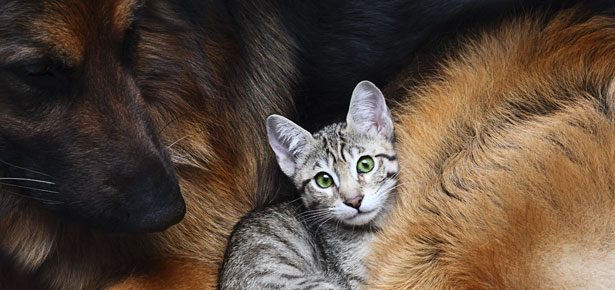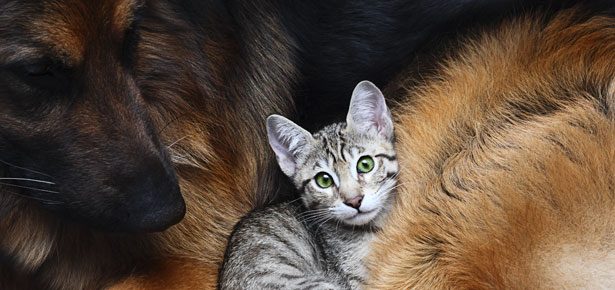

Interspecies Friendships: When Cats Join the Pack
Some Dogs Will Welcome Just About Anybody into their Pack
We've all heard the expression "fighting like cats and dogs", and most of us have had the experience of watching a normally docile dog take off like a slavering maniac after some neighbourhood cat, squirrel, bird or other hapless creature. Yet despite the instinctive prey drive so natural to canines, there are certain dogs who display a remarkable capacity to bond with animals of other species, making for some wondrously odd friendships.
My Alaskan Malamute, Kodi, was one such dog. From a very early age, he showed an unusual predilection for interspecies friendships, becoming fast friends with the neighbour's cat, my pet rabbit, and a horse with whom he would play rollicking games of tag. However, it wasn't until I brought home a little white kitten named Myshkin that I learned just how deep the interspecies bond could be.
Myshkin, all of ten weeks old, immediately attached himself to Kodi, trotting after him everywhere he went. Myshkin soon took to sleeping on top of Kodi, and the big dog would patiently endure the little claws that dug into his back as Myshkin, purring all the while, kneaded his furry "bed." As the years passed, the love that grew between Kodi and Myshkin was manifest in many forms, from the way Kodi would gently "swallow" Myshkin's head when the cat misbehaved, to the way Myshkin would follow along on all our neighbourhood jaunts, sitting proudly beside Kodi outside the local shops.
As close as they were, it seemed natural that Kodi was fiercely protective of Myshkin, ready to fight off any dog who threatened "his" cat. What was truly remarkable, though, was how this protectiveness turned around when Kodi became stricken with cancer at the end of his life. Myshkin, obviously aware that his beloved friend was gravely ill, was seldom more than a few feet from Kodi's side. I thought the cat just wanted to stick close to his best friend, but what I didn't realize was that Myshkin was actually guarding him.
This became evident one afternoon toward the very end, when I witnessed an encounter that was a true testimony to the friendship between the two animals. Kodi, too weak to walk, had been carried out to the front lawn and was resting there with Myshkin beside him. Suddenly, a huge black dog appeared up the street, heading our way with no owner around. Normally, the sight of a strange dog would send Myshkin running for cover until Kodi chased it off, but this day, Myshkin held his ground. As the big dog approached, Myshkin stood up and moved directly into its path, puffing himself up and growling like something possessed. The dog tried to go around him to get a sniff at Kodi, but any way he turned, Myshkin blocked him with his own tiny body-left, right, then left again.
The poor cat was clearly terrified, yet there he was, risking his own life to protect the helpless friend who had been his guide and guardian for so many years. The stray dog soon gave up and departed, leaving me with a lump in my throat- and a sense of awe that remains to this day.
I still marvel at that display of courage, and at the deep and abiding friendship it made so poignantly clear. However, I have since learned that interspecies bonding between dogs and other animals is more common that one might think. Dogs, in fact, have been known to form close friendships with all manner of creatures, including birds, rodents, camels, lions, monkeys, llamas and just about anything else you could think of.
One man who has witnessed and documented many such friendships is the renowned British photographer John Drysdale. His latest book, My Love Unleashed, is a collection of dog portraits that contains many remarkable photographs of dogs and their non-canine animal friends. According to Drysdale, such relationships can easily develop if a dog and the other animal are raised together from a young age, but he has also seen a number of interesting instances where fully mature animals have taken to each other.
His 1970 photo "The Rescued and the Proud," for example, illustrates the truly amazing friendship that sprang up between a grown dog and an injured seagull. "While walking along the beach," Drysdale relates, "the Mastiff-Labrador cross found this seagull with a missing wing and gently carried it home to his owners. He then promptly adopted the little gull. Strangely, so did the three cats with whom he lived. Via the infliction of an occasional sharp peck, the one-winged seagull quickly took over and became boss of the house-but with affection unchanging for his dear friend and rescuer."
Drysdale has also photographed a number of unusual relationships that developed through dogs being brought in to nurse or nurture orphaned babies of other species. "I've come across quite a few bitches who were used for suckling young animals that would otherwise require bottle feeding," he says. "The strangest of all was a tiger that grew up with a dog, to maturity, and the tiger considered the dog the master even after the tiger was fully grown and could have easily killed the dog with one swipe of the paw."
Then there was Suzie, the Bulldog who became the adoptive mother of three orphaned squirrels-and the subject of one of Drysdale's most famous photographs. "Suzie's puppies had recently been sold when someone brought three tiny grey squirrels to the farm where she lived," explains Drysdale. "Assuming they had been abandoned by their mother, the farmer undertook the laborious task of feeding the squirrels with a syringe every two hours. He then successfully transferred nursing to Suzie, whose strong maternal instincts welcomed them. The squirrels accepted the Bulldog as their mother, and meanwhile Suzie of the fearsome look and gentle nature was happy in her mothering role-no longer forlorn over the loss of her puppies."
Sometimes, in Drysdale's experience, it is the other animal who ends up taking care of the dog, as was the case with a shy, gentle Boston Terrier with the inappropriate name of Bossy. "Bossy was constantly being harassed by rough, neighbouring dogs near his home in Oundle, England," recalls Drysdale. "When his mistress was asked to bottlefeed an abandoned lion cub, she brought it to Bossy for company. They became friends, and as Sylvia the lion cub grew bigger, she became very protective of the Boston Terrier. The aggressive dogs wisely avoided the pair, and Bossy, at last free of their torment and happy with his beloved Sylvia, smiled and laughed a lot."
Those of us lucky enough to have dogs with unusual friends also tend to smile and laugh a lot. Just ask Jeanne Hale of Palmer, Alaska, whose Boxer, Rosie, was inseparable friends with a ferret named Cookie. As Hale recalls, "They had several really funny games they would play: hide and seek, jump on the dog, tug of war with socks, and boxing ferret style-in which the ferret would grab the dog's loose upper lip with her teeth and hang on! You could tell it sometimes hurt Rosie, but that was okay because it was ‘her' ferret." The ferret would also steal Rosie's toys, but made up for it by snatching things off the Christmas tree and bringing them to Rosie, much to Hale's amusement.
Micah Shawn of Farmington, Michigan, was similarly delighted when her male Husky-Shepherd mix, Chowder, became the friend and selfappointed guardian of her stepdaughter Alison's guinea pig, Pip. "We would often come home to find Chowder sleeping up against Pip's cage," says Shawn. "Whenever Alison cleaned Pip's cage, she would place Pip between Chowder's front paws. He would cross his paws to keep her there, and if she tried to climb out he would gently lower his muzzle on top of her to keep her from climbing out." The dog often sought out his little friend's company, and seemed to particularly enjoy having the guinea pig placed on his back, bringing a warm smile to all.
Dustin Aalder's home in Nova Scotia is also provided with plenty of smiles, thanks to a Chihuahua named Duchess and her best friends, a collection of fancy rats. "Duchess just loves to play with the rats," laughs Aalder. "She'll groom them, they'll groom her… they'll chew on her collar. When they hide in the blankets, she digs around searching for them." Unusual as it seems, Aalder has no doubt that Duchess and the rats truly love each other. "Oh, they get along famously. The rats get excited and cling to the bars when Duchess gets close to their cage because they love her so much. And as soon as I take the rats out, Duchess jumps up and down until I put one on the bed or floor for her to play with. I've even had her curl up on a chair with one and sleep. She can't get enough of them, and vice versa!"
Those of us who have dogs that will chase down any critter that moves may find these interspecies friendships totally incredible, but according to Dr. Stanley Coren, an expert in psychology, they are simply a by-product of the traits we have selectively bred into domestic dogs. "Dogs have been genetically modified by us to be extremely sociable and extremely accepting," says Coren, though he points out that this varies from breed to breed. "Generally speaking, the issue is something we call neotony. Neotony simply refers to the fact that we have bred our dogs so that they are effectively puppies for their entire lives." The more highly neotonized breeds-characterized by floppy ears, large round eyes and shorter snouts-are far more likely to be friendly and tolerant towards other animals, according to Coren.
Interspecies friendships can be formed by dogs of the less neotonized breeds-the more wolf-like dogs marked by such characteristics as upright ears, longer snouts, and typically powerful prey drives-but this is far less common. "When these things happen with the less neotonized dogs," explains Coren, "it will usually be an association involving a very young animal. Part of the reason for this is that very young mammals have pheromones that give them a characteristic ‘baby smell.' One of the purposes of these pheromones is to excite protective instincts, or at least non-hostile instincts, in its own species. However, because of the similarity amongst all the mammals, we tend to find that other animals will respond to it." This, Coren says, will sometimes protect a young animal long enough for a bond to form with a dog.
Science and psychology aside, there is an undeniable magic in the special relationships dogs form with other animals. Perhaps it is the example they set for us, proving that love truly knows no bounds. After all, if a dog and a cat can be best friends-or a dog and a rat, chimp, seagull or ferret-perhaps we can learn to overlook the far less extreme differences that exist among people. ■
Susan Kauffmann is a Vancouver writer who lives with her Alaskan Malamute, Kuma, and her cat, Myshkin-who still comes along on "dog" walks.
Join the newsletter and never miss out on dog content again!
"*" indicates required fields
By clicking the arrow, you agree to our web Terms of Use and Privacy & Cookie Policy. Easy unsubscribe links are provided in every email.